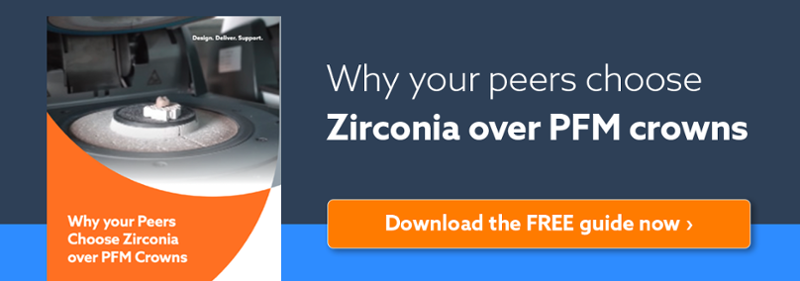The number of Zirconia crowns fabricated annually now exceeds PFM crowns. With this trend likely to continue, it is crucial to know how best to place zirconia crowns. Often, the fit and appearance of a crown can be enhanced by making a few simple changes.
Improving Aesthetics of Zirconia Crowns
Some clinicians have found that zirconia crowns frequently appear lighter than the requested shade. This problem has been addressed with the introduction of more aesthetic zirconia products. For clinicians who are facing this issue, it is recommended to email the dental lab a photo of the tooth to be restored with the shade tab adjacent to the relevant tooth. Emailing these images prevents the color distortion that can occur during printing.
Preventing Zirconia Crowns from Debonding
If you find your zirconia crowns are debonding, adjusting the cementation process could help. Most clinicians will typically try in the zirconia crown, before cleaning the tooth with pumice or something similar. They will then decontaminate the intaglio of the zirconia restoration, before preparing it with a priming agent or adhesive, ready for cementation. Some cement has a primer built-in. The crown is cemented in place, tack cured, and the excess cement removed.
These are all standard procedures, but often, failing to decontaminate the intaglio thoroughly could cause the bonding process to fail. The zirconia used in dentistry is zirconium oxide and these oxide sites bond with functional phosphate groups.
One crucial factor to remember is that saliva contains phosphate and once the crown is tried in the mouth, it encounters these phosphate groups that will occupy the oxide sites. These phosphate groups must be removed so the oxide sites can bond successfully.
Several methods can remove these phosphate groups:
-
Sandblasting. Although sandblasting the internal surface with 50 micron diameter aluminum oxide is usually not recommended, some manufacturers do recommend sandblasting the internal surface very lightly, and at low pressure. Always refer to the manufacturer’s recommendations.
-
Sodium hypochlorite. The intaglio of the crown is wiped with gauze soaked in a 5% concentration of sodium hypochlorite, which is removed by rinsing with water and air-drying the restoration.
-
Ivoclean. Use a proprietary solution such as Ivoclean, which is zirconium oxide in a liquid suspension. The solution is left on the crown for 20 seconds before it is rinsed away. The crown is air-dried and is ready to bond.
Ensuring Restorations Don’t Rock Facial-Lingually
Do you find the margins of zirconia crowns fit perfectly, but that the crown rocks facial-lingually? This is a common problem and fitting the crown takes far longer than anticipated. When the digital image of the tooth is constructed, any irregularities are removed as milled restorations have smooth surfaces internally and will not fit over irregularities or undercuts.
Usually, a die-spacer is used on conventional models, which creates a space of approximately 50-100 microns. When fabricating zirconia restorations, the technician will ensure the computer program is set to create well-fitting margins, while specifying the size of the space between the fit surface and the prep; this replicates the function of a conventional die-spacer. If the space is too large, the restoration could rock when you try to seat it.
When you are experiencing fit issues, call the lab directly to discuss your case with our expert technical team. DDS Lab’s technical team is ready to help solve any issues regarding restorations and will work with your office to find the best solutions.
Click here to schedule a consultation with our technical team »

References
https://www.dentaleconomics.com/articles/print/volume-106/issue-7/science-tech/cementing-zirconia-restorations.html
https://www.dentaleconomics.com/articles/print/volume-97/issue-9/departments/ask-dr-christensen/ask-dr-christensen.html
https://multimedia.3m.com/mws/media/1480758O/dental-economics-sept-2017-article-by-dr-ganci.pdf